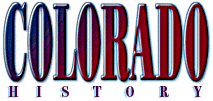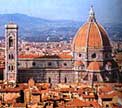|
Highlands Ranch High School - Mr. Sedivy
Highlands Ranch, Colorado

- Colorado History -
Fort Union
By David Sedivy
Sumner - Ninth Military Department
Sumner arrived in Santa Fe on July 19, 1851. His first act as commanding
officer was to "break up the post at Santa Fe, that sink of vice
and extravagance, and to remove the troops and public property to
this place (Fort Union). I left one company of Artillery there...
These evils are so great that I do not expect to eradicate them entirely
until I can bring the troops together in considerable bodies..."4 Sumner believed that removing all the troops from town would
improve discipline and moral. Sumner resented the townspeople of Santa
Fe living in one way or another at government expense. He was determined
to cut back the waste in government spending.

Fort Union, New Mexico Territory. In fifteen years,
$40,000,000 was spent
keeping the Plains Indians under control and the Santa Fe Trail open.
The Ninth Military Department under command of Sumner first arrived
at what would later be called Fort Union on July 26, 1851.5
Sumner began construction at a strategic location five miles from
the Rio Mora on El Arroyo del Coyote near the Turkey Mountains. The
sight was six miles north east of the confluence of the Cimarron and
Mountain routes of the Santa Fe Trail, twenty-six miles from Las Vegas,
and eighteen miles from Mora.6 One army summary
stated that "the location was on the line of the great traveled
route to Santa Fe, with a view to the protection of passing wagon
trains and the isolated settlements from the Apaches who roamed over
the wide district of country to the east and south".7
Temporary Buildings
When the army moved into the area of Fort Union in 1851, the first
order of business was the construction of temporary shelters while
the construction of the more permanent shelters could be made. A report
prepared in August, 1851 summarized the resources of the area. Corn
and hay were available for purchase, and the grazing around the post
was very good during the summer and fall.
The report noted:
There is sufficient building materials
near the post for all purposes, consisting of a very fine white sand
stone, clay for bricks and adobes and pitch and spruce pine in the
mountains from 9 to 30 miles of the post. All other articles required
for building would have to come from the east, as they are not produced
by this department... The greatest objection to this point as a military
post is the want of running water for stock... The usual and only
transportation used here are wagons, carts, and pack mules.8
Despite various Army regulations that governed building construction
in the late 1800s frontier army construction was rag-tag at best.
As one historian pointed out, the only thing uniform about the army
in the ninetieth century was its uniform.9 With fall and winter approaching construction of quarters was
the first priority. The new occupants lived in army tents while buildings
were under construction. The rough, unpeeled log buildings went up
slowly.
Progress Report
By December 1851, the quarters were still short of completion, but
the availability of boards for roofs and floors had improved.

Hopkins Sibley
A progress report from Major Sibley noted:
The quarters for one company and the
hospital are competed except the glazing of the windows, and the hanging
of the doors. I am now busily occupied in sawing the lumber necessary
to cover the other soldiers quarters. The officers quarters are all
covered and, with a few exceptions, floors are laid in one room of
each set and the quarters are occupied by officers and their families.10

Drawing of Fort Union soon after the military post
was established.
This illustration appeared in "El Gringo" or New Mexico
and Her People in 1857.
The First Fort Union
By April 1852, Sibley reported to his superiors that with the exception
of a few shops and a storehouse, all of the buildings had been erected
and were in a relatively habitable condition. By September 1852, the
first Fort Union was operating efficiently.11
Fort Union
| The Sante Fe Trail and Fort Union |
| Sumner - Ninth Military Department / The
First Fort Union |
| Early Arrivals to Fort Union, Daily Life
at Fort Union |
| Captain Grover - The New Fort Union, the
Confederate Threat |
| Fort Union Arsenal, William Shoemaker,
End of Fort Union |
Bibliography is available by email
request.
Back to the top of page
- Colorado History In Depth
-
Lecture Notes, Reading, and Information:
| The Cheyenne Migration
to Colorado |
| The Gratlan Affair, Massacre, Fort Laramie
Treaty |
The Cheyenne Social Club
| A Cheyenne War Story: Wolf Road, the Runner
|
| Cheyenne Traditions and Beliefs, Sacred
Stories |
| Horses, Warriors, War Pipe, Sweatlodge
Ceremony |
| Cheyenne War Parties and Battle Tactics
|
| The Scalp Dance and Other Cheyenne Dances
|
Americans from the East
| Thomas Jefferson, the Louisiana Purchase
|
| The Expedition of Zebulon Pike |
| Pikes Peak or Bust / Colorado Gold Rush
|
Colorado's Role in the US Civil
War
| The Civil War, Fort Wise / Fort Lyon
|
| Mace's Hole, Colonel Canby, F.C.V.R.
| Fort Weld |
| The Pet Lambs, John Chivington |
| General Henry Sibly, Battle of Valverde,
Fort Union |
Cripple Creek District Labor Strikes
| The Western Federation of Miners / State
Militia |
| The 1893 - 1894 Strike | The
Strike of 1903 - 1904 |
| The Mine Owners Association |
| Crimes and Military Rule in the Cripple
Creek District |
| Marshall Law in Cripple Creek District
/ End of the Strike |
Early Cripple Creek District
| Photos, Fire, and Life in Cripple Creek
|
| Other Colorful Towns in the Cripple Creek
District:
Gillett - Colorado's Only Bullfight, Victor, Independence |
| A Guide to the Miners' Gritty Lingo
|
More Colorado History
Information
| Bent's Fort Photos, Personalities, Plans,
and More |
| What Was Easter Like at Bent's Fort?
|
| Colorado Trivia,
Miscellaneous Old Photos,
Western Personalities, Forts, and More |
| Lullabies for Jittery Cows - Cowboy Ballads
|
| Heraldry of the Branding Iron |
| Project
Aims to Clear Infamous Cannibal, Alferd Packer |
| Lead Gives Alferd
Packer's Story More Weight |
| Legendary
Colorado Love Stories: Baby Doe Tabor & More
|
| Colorado Pioneer Women: Elizabeth Byers
|
| Early Denver Jokes / The History of April
Fools' Day |
Back to the top of page
|



![]() 9375 South Cresthill Lane
9375 South Cresthill Lane ![]() Highlands Ranch, Colorado 80126
Highlands Ranch, Colorado 80126 ![]() 303-471-7000
303-471-7000



